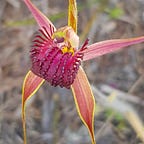Cassytha, She looks so pretty and dangerous,
Day 36 , Cassytha, Dodder Laurel , a plant a day, Lowlands Coastal Reserve, 29 November 2020
Like the mistletoe, Dodder laurel or Cassytha is a parasite. Specifically, it is a stem hemiparasite, as its suckers latch on to the host plant to share, or steal its nutrients from the host plant’s xylem. The seeds germinate in the ground before detaching themselves and losing contact with the soil , and Cassytha is then wholly dependent on its host.
I admire our Lowlands Cassytha, although it is sometimes maligned for killing its host, I think it looks so pretty and dangerous. Tiny white flowers and an attractive twining habit , but lethal looking teeth, which are actually suckers. A very powerful plant, it can even be a parasite on tough old sword grass (Lepidosperma gladiatum) , it can also parasitise itself and sometimes is cheeky enough to piggyback onto another parasitic plant , like the root hemiparasite , Olax phyllanthi. Cassytha is not fussy in Lowlands Reserve, sometimes latching on to the low growing ground cover Royal Robe, or even overwhelming the nearly 2 metre tall Bossiae shrubs.
It has its place in the ecosystem, providing nutrient rich mulch when it eventually dies , and also a niche habitat for our local fauna, and the fruits feed the birds.
It is a bush tucker/medicinal plant (laxative), but please leave the fruits for the birds, as they contain alkaloids which aren’t the best for human consumption in large amounts — the fruits are pretty small though. https://www.publish.csiro.au/ch/CH9671457
In any case, unless you are of Aboriginal descent, you are not allowed to take plants, or parts of plants from the bush without a licence.
Other Noongar uses of this plant are decorative/ceremonial, as a useful source of binding cord and most importantly in fish traps as it forms n impenetrable net which traps fish.
West Australian 13 November 1937
OLD FISH WEIRS. A South Coast Custom. Recently a correspondent from the Eastern States wrote to the Western Australian Historical Society asking if there were any traces near Oyster Harbour, Albany, of stone Aboriginal-built fish weirs, which were mentioned in accounts of voyages written by early French and English explorers. Writing to the Katanning branch of the Historical Society recently Mr. H. Baker said that in 1935 when staying at Emu Point he was told by Mr. Swarbrick, the well-known fisherman and boat proprietor, that the remains of an old stone fish weir existed either In Oyster Harbour or at one of the beaches on the ocean side of that harbour. He understood that the weir was so constructed that fish swam into it at high tide to feed and were left stranded in shallow water after the tide receded.
‘I might mention,” continued Mr. Baker, “that an effective method of catching fish was used by the Aboriginal people in the small river and creek estuaries on the south coast, in the vicinity of Doubtful Island, Gairdner River and Kelly’s Creek. The Aboriginal people gathered large quantities of a parasite bush creeper, with long, clinging tendrils, welded it together in the form of a net-like mass and pushed it up the river or creek they were fishing. The mass was quite Impenetrable to fish and stretched from bank to bank, and large numbers of people operated it. The fish were driven to the end of the creek or estuary and virtually ‘fenced-off,’ where they were easily caught by the hunters. I have reason to believe,” added Mr. Baker, “that this method was used by many Aboriginal communities living on the coastal areas.”
“She looks so pretty and dangerous” is a line from a Paul Kelly song, which I sing to myself when I walk in the deep places in Lowlands Reserve where Cassytha grows and overwhelms the Bossiae linophylla.
Other names for Cassytha include devil’s twine and the love vine, both of which seem more appropriate to me than ‘Dodder Laurel”. Mistletoe and parasitic plants have long been fascinating to humans, reputed to have miraculous healing properties in Norse myth and also as an aphrodisiac , kissing under the mistletoe, being a case in point. SW of Australia has over 50 species of parasitic plants, compared with only a couple of parasitic species commonly occurring in Northern Europe, as plants evolved here over millenia to cope with our ancient and nutrient poor environment. Djuk, which I featured on Day 34, being a root parasite, is also one of those 50 odd specially adapted plants.
Writing this daily blog featuring a plant a day and walking daily is my fundraising effort for Bush Heritage #groundworkchallenge . To join my team or donate go to https://www.groundworkchallenge.org.au/fundraisers/sheilamurray/2020?fbclid=IwAR2HbNn0YsCCc3tiSK-_lbF5xLsssaD8wjGHaUwVYrRqYxM-kdJkijoj2N0
Lowlands Coastal Reserve is on Menang Boodja — country. I celebrate the strength, resilience and capacity of the Menang Noongar people who are the traditional owners of the land.
Lowlands Coastal Reserve is managed by the local community and the City of Albany. Bush Heritage Australia manage many other wonderful reserves.
Follow me on instagram and twitter @lowlandsbeach . https://www.instagram.com/lowlandsbeach/
https://twitter.com/lowlandsbeach
and on Linked in https://www.linkedin.com/in/sheila-murray-2730491bb/
